The dimensions of the refrigerator affect the choice of a particular model when purchasing it. The dimensions of the device should allow it to store in it a sufficient volume and range of products for the family. At the same time, especially in small apartments, the refrigerator should not occupy half of the kitchen or block the routes of the hostess. If the refrigeration unit will be built into kitchen furniture - it is necessary to coordinate its dimensions with the dimensions of the corresponding module.
Dimensions of the refrigerator: standard height and width
The dimensions of the purchased refrigerator should be selected so that when you open the doors do not rest against the walls or objects of kitchen furniture. Moreover, its door should open so as to provide convenient access from the side of the cooking surface and from the dining table.
The ratio of the sizes of the refrigerator and freezer is chosen depending on the dietary preferences: if the family prefers fresh food and daily cooking, the refrigerator should be larger, if the emphasis is on frozen foods and semi-finished products - you need a large freezer.
According to their overall dimensions, refrigerators are divided into several groups:
- Refrigerator bars. Most models are built-in. Their standard width is 50 cm, height is 50-110 cm.
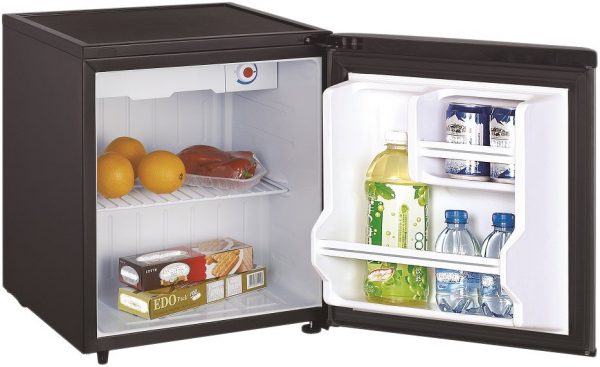
Mini devices
- Small refrigeration units. In small devices, the freezer is most often located on top, designed for single or small families. The width of such refrigerators (standard) is 50 cm, the height is up to 150 cm, the depth is 60 cm.
- Medium models. Height reaches 180 cm. Width 50 - 60 cm, depth - 60 cm. The freezer is often located below and has a separate door. Most embedded models belong to this class.
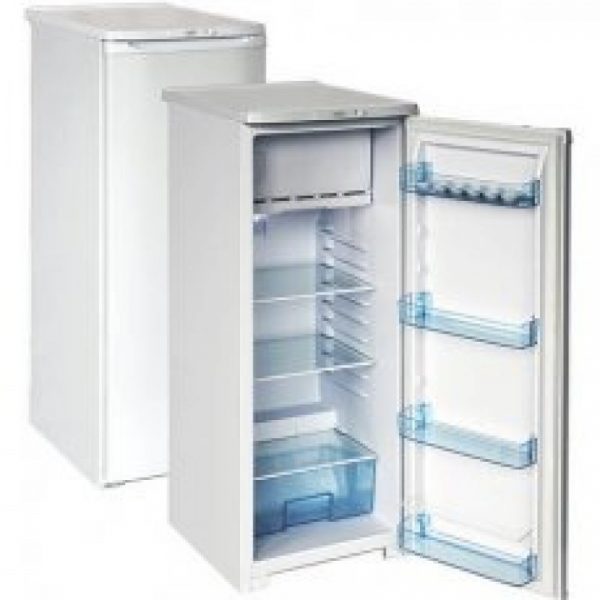
Mid-size models
- High refrigeration units. Height reaches 210 cm, these devices have a large volume and are able to store a supply of products for a complete family. It is difficult for people of short stature and children to reach the upper shelves. Width - 60 cm (50 cm for built-in), depth - 60 cm.

Tall models
- Side-by-side devices. Large devices resemble a small apartment. They have two doors swinging open towards each other, one for the freezer, the other for the refrigerator compartment. The width reaches 120 cm, the depth is 60-80 cm. The height is 170-210 cm. It allows a large family not to limit themselves in a place to store fresh and chilled products.
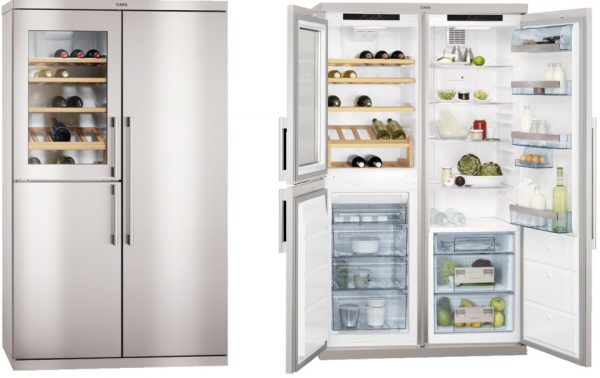
Double Side-by-Side
Each customer can choose a model that meets his needs and capabilities.
Maximum height and width
The table shows the maximum and minimum sizes for different groups of refrigerators.
| Group | Height cm | Width cm | Depth cm |
| Small | 50-110 | 50-60 | 60 |
| Medium | 120-150 | 50-60 | 60 |
| High | 150-180 | 50-60 | 60 |
| Europe | 170-210 | 55-65 | 55-65 |
| Two door | 170-210 | Up to 120 | 60-80 |
| Asia | 160-180 | 55-80 | 55-65 |
In Asian countries with small average population growth, the standard size of refrigerators manufactured is slightly smaller. In Europe, where consumption standards are higher, a larger size is used, while the refrigerator is made higher, but often narrower.
Double-leaf refrigerator: dimensions
The dimensions of double-wing devices depend on the specific model and are diverse.
- Width 80 - 120 cm. Some models reach 140 cm.
- Height 170 - 210 cm.
- The standard depth is 60 cm. Models with a depth of up to 90 cm are available for the American market.Their freezer allows you to store parts of meat carcasses.
Built-in two-door models have dimensions that are multiples of standard kitchen modules and 60 cm deep. Free-standing devices can also be large.

One of the largest refrigeration centers
Selection of the refrigerator by size
How to choose the size of the device? The selection of the principle “the more the better” does not work here. Large sizes mean a large footprint, and a large consumption of electricity. In addition to the area occupied by the base of the device, it is necessary to take into account the place for free opening of the camera doors. There should be enough space to move around the kitchen. The right choice is the balance between the volume of the cameras, the energy consumed and the space occupied.
It is also necessary to evaluate the growth of family members - whether everyone can reach the upper shelves. If the family has children or people of small stature, it makes sense to look at lower and wider models with the same volume of cameras.
If you plan to integrate household appliances into the kitchen, the width and height of the purchased refrigerator should be a multiple of the standard furniture modules - 30, 40, 50 or 60 cm, and the depth - no more than 60 cm.
Installation Rules
When developing a kitchen design, experts recommend following the following rules:
- The distance from the side wall to the stove (hob) and the radiator of the heating system must be at least half a meter.
- It is also not recommended to place the unit near the sink.
- Avoid direct sunlight. This will lead to increased energy consumption.
- There should be a gap of at least 5 cm between the rear panel and the wall. It is required to ensure the free exit of heated air from the heat exchanger up.
When opening the doors, they should not block the passage and prevent food from reaching the cooking surface or dining table
Mini fridge: sizes
Such devices are often bought in apartments, studio apartments and hotel rooms. Often a separate unit is placed in the living room or office. they are used to cool and store drinks and snacks, as well as ice making. They are also called bar fridges. Most models are built-in. Their standard width is 50 cm, height is 50-110 cm. The depth does not exceed 60 cm.
Niche size for the refrigerator
When designing a kitchen set with integrated household appliances, it is necessary to take into account its dimensions and compare them with standard furniture modules. This will allow the use of standard faceplates that are affordable. The manufacture of such panels on an individual order leads to a significant rise in price.
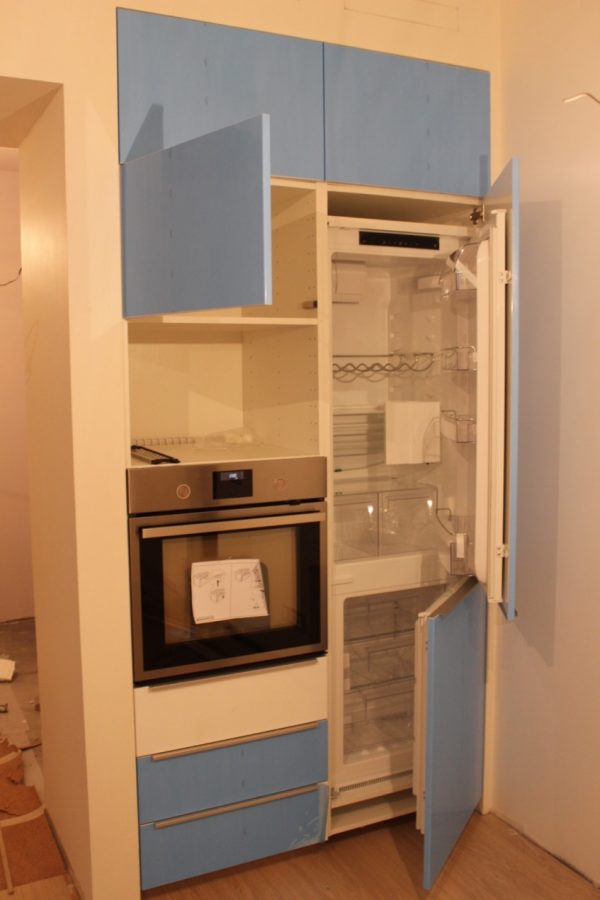
Built-in refrigerator
The documentation for any built-in refrigerator indicates both its dimensions and requirements for the dimensions of the niche prepared for the refrigerator.
A mandatory requirement is a gap of at least 5 cm between the rear panel and the wall of the niche. In addition, it is necessary to ensure the flow of cold and the removal of heated air from the heat exchanger. To do this, make two rows of holes with a diameter of 3-5 cm in the lower and upper part of the niche for installing the device. In the absence of air circulation, the refrigerator will work inefficiently, not reaching the set cooling temperature and with increased energy consumption.
If you select all the equipment of one manufacturer, then it will usually be one standard width and depth. This facilitates the layout of the kitchen set so that the equipment can be conveniently used.
If it is planned to use already existing household appliances, this will save money, but the task of designing optimal from the point of view of ergonomics is complicated.
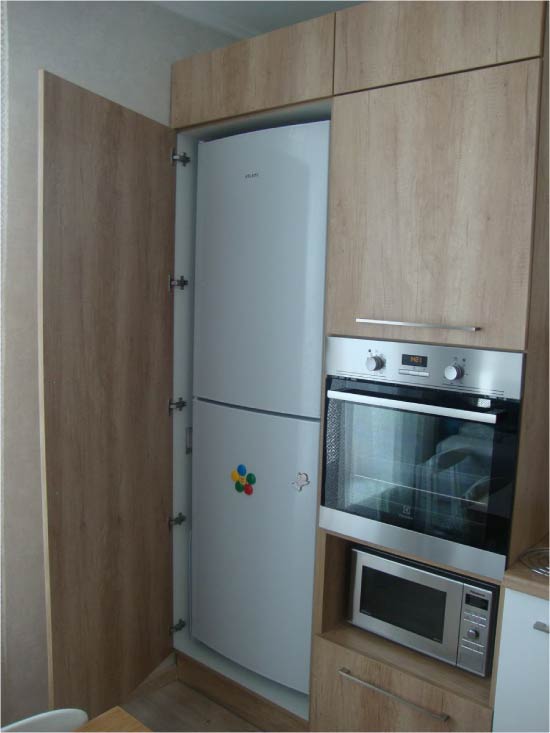
Conventional unit in a niche
An integrated refrigeration unit improves the look of the kitchen. However, the choice of a freestanding model also has its advantages.The user is not limited to the standard sizes of furniture modules, but can buy a unit that meets his needs in terms of the volume of the freezer and refrigerator.
Of course, the area of an apartment or house should allow to place such an apparatus.



